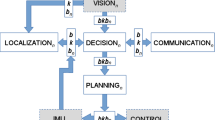Abstract
This paper presents a human–computer cooperation platform, which permits the coordination between the user and the tool to improve the development of real-time control applications (e.g., mobile robots). These applications have functional (robot objectives) and temporal requirements to accomplish (deadlines guarantee of tasks). The simulation tool has been designed in order to permit the testing and validation of these two requirements. To this end, the tool is composed of two independent simulators interconnected through a shared memory: the robot simulator (functional level) and the real-time task scheduler simulator (task execution level). Robotic applications can be defined with the robot simulator while the real-time scheduler simulator permits to analyze the schedulability of the robotic tasks. The real-time task simulator incorporates a flexible task model where the task temporal parameters (e.g., computation time) adapt to the requirements of the application (e.g., number of objects in scenes); thus, the use of the CPU is not overestimated. A key issue of the framework is the human–computer interface, which allows the monitoring of different parameters of the application: robot objectives, task schedule, robot speed, computation time, CPU utilization, deadline misses. The usefulness of the simulation tool is shown through different robotic navigation experiments. Finally, the simulation tool has been used to evaluate the proposed flexible model of tasks compared to a traditional fixed temporal parameters task model. Results show that the robot fulfills the objectives earlier, about 32% on average, and consumes on average about 15% less CPU to accomplish the objectives.















Similar content being viewed by others
References
Dominguez C, Hassan H, Crespo A (2007) Real-time embedded architecture for pervasive robots. In: The 2007 International Conference on Intelligent Pervasive Computing (IPC 2007), pp 531–536
Audsley NC, Burns A, Davis RI, Tindell KW, Wellings AJ (1995) Fixed priority pre-emptive scheduling: an historical perspective. Real Time Syst 8(2–3):173–198
Stankovic JA, Lee I, Mok A, Rajkumar R (2005) Opportunities and obligations for physical computing systems. Computer 38(11):23–31
Zhen Z, Qixin C, Lo C, Lei Z (2009) A CORBA-based simulation and control framework for mobile robots. Robotica 27(3):459
Ferretti G, Magnani G, Porrati P, Rizzi G, Rocco P, Rusconi A (2008) Real-time simulation of a space robotic arm. In: IROS
Qadi A, Goddard S, Huang J, Farritor S (2005) A performance and schedulability analysis of an autonomous mobile robot. In: 17th Euromicro Conference on Real-Time Systems (ECRTS’05), pp 239–248
Goud GR, Sharma N, Ramamritham K, Malewar S (2006) Efficient real-time support for automotive applications: a case study. In: 12th IEEE International Conference on Embedded and Real-Time Computing Systems and Applications (RTCSA’06), pp 335–341
Pedreiras P, Luis A (2003) The flexible time-triggered (FTT) paradigm: an approach to QoS management in distributed real-time systems. In: Proceedings International Parallel and Distributed Processing Symposium, p 9
Li H, Sweeney J, Ramamritham K, Grupen R, Shenoy P (2003) Real-time support for mobile robotics. In: The 9th IEEE Real-Time and Embedded Technology and Applications Symposium. Proceedings, pp 10–18
Chetto H, Chetto M (1989) Some results of the earliest deadline scheduling algorithm. IEEE Trans Softw Eng 15(10):1261–1269
Liu R, Zhang X (2017) Systems of natural-language-facilitated human-robot cooperation: a review. arXiv:1701.08269v2
Tsarouchi P, Makris S, Chryssolouris G (2016) Human–robot interaction review and challenges on task planning and programming. Int J Comput Integr Manuf 29(8):916–931
Moniz A (2013) Organizational concepts and interaction between humans and robots in industrial environments. In: IEEE-RAS-IARP Joint Workshop on Technical Challenges for Dependable Robots in Human Environment, Tokyo
Mayer MP, Odenthal B, Faber M, Winkelholz C, Schlick CM (2014) Cognitive engineering of automated assembly processes. Hum Factors Ergon Manuf Serv Ind 24(3):348–368
Agostini A, Torras C, Wörgötter F (2011) Integrating task planning and interactive learning for robots to work in human environments. In: IJCAI
Kwon W, Suh I (2014) Planning of proactive behaviors for human–robot cooperative tasks under uncertainty. Knowl Based Syst 72:81–95
Chen F, Sekiyama K, Sasaki H, Huang J, Sun B, Fukuda T (2011) Assembly strategy modeling and selection for human and robot coordinated cell assembly. In: 2011 IEEE/RSJ International Conference on Intelligent Robots and Systems, pp 4670–4675
Gombolay M, Wilcox R, Diaz A, Yu F (2013) Towards successful coordination of human and robotic work using automated scheduling tools: an initial pilot study. In: Proceedings of Robotics: Science and Systems, Human–Robot Collaboration Workshop
Gombolay MC, Gutierrez RA, Clarke SG, Sturla GF, Shah JA (2015) Decision-making authority, team efficiency and human worker satisfaction in mixed human–robot teams. Auton Robots 39(3):293–312
Frontoni E, Mancini A, Caponetti F, Zingaretti P (2006) A framework for simulations and tests of mobile robotics tasks. In: 2006 14th Mediterranean Conference on Control and Automation, pp 1–6
I. Embarcadero Technologies, C++ Builder 10.2. https://www.embarcadero.com/
Author information
Authors and Affiliations
Corresponding author
Rights and permissions
About this article
Cite this article
Domínguez, C., Martínez, JM., Busquets-Mataix, J.V. et al. Human–computer cooperation platform for developing real-time robotic applications. J Supercomput 75, 1849–1868 (2019). https://doi.org/10.1007/s11227-018-2343-4
Published:
Issue Date:
DOI: https://doi.org/10.1007/s11227-018-2343-4




